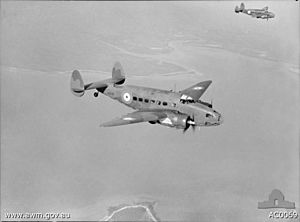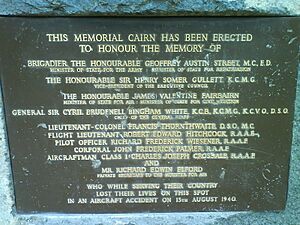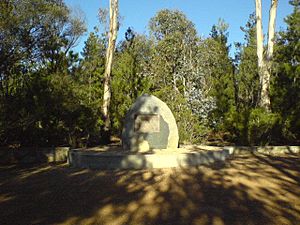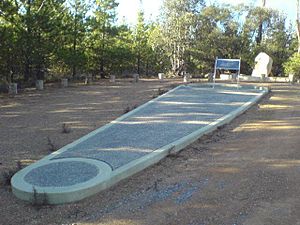1940 Canberra air disaster facts for kids
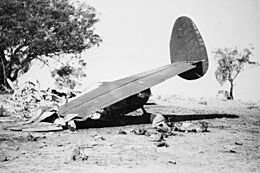
Wreckage of A16-97
|
|
| Accident summary | |
|---|---|
| Date | 13 August 1940 |
| Summary | Stall on landing |
| Place | Canberra, Australian Capital Territory 35°19′06″S 149°13′45″E / 35.3184°S 149.2293°E |
| Passengers | 6 |
| Crew | 4 |
| Fatalities | 10 |
| Survivors | 0 |
| Aircraft type | Lockheed Hudson |
| Airline/user | Royal Australian Air Force |
| Registration | A16-97 |
| Flew from | Essendon Airport |
| Flying to | Canberra Airport |
The 1940 Canberra air disaster was a terrible plane crash that happened near Canberra, Australia's capital city. It occurred on 13 August 1940, during World War II. All ten people on board died. This included six passengers and four crew members. Among the passengers were three important government ministers and the head of the Australian Army.
Experts believe the plane lost power and control as it was trying to land. It was too low to recover from this problem. The deaths of the three government ministers made the government of Robert Menzies much weaker. This event played a part in his government falling in 1941.
Contents
What Happened Before the Crash?
The plane involved in the crash was a Lockheed Hudson bomber, named A16-97. It was one of many new planes ordered for the Royal Australian Air Force (RAAF). This particular plane was special because it was the first Hudson in the RAAF to have seats for passengers. It was used to carry important supplies and people, including government ministers.
On 9 August 1940, the RAAF was asked to prepare a flight to Canberra for 13 August. This flight was for James Fairbairn, who was the minister for air and civil aviation. The plane had only flown for a short time before this trip. The pilot, Bob Hitchcock, checked the plane that morning. He and three crew members then flew from RAAF Laverton to Essendon Airport.
Minister Fairbairn needed to attend a very important meeting in Canberra. This meeting was about Australia's plans for World War II. Other important leaders were also going to be there. Fairbairn invited three other senior officials to fly with him:
- Geoffrey Street, the Minister for the Army.
- Henry Gullett, the Minister for Information.
- General Brudenell White, the head of the Army.
Two of their assistants, Dick Elford and Frank Thornthwaite, also joined the flight. Other ministers were invited but chose to take the train instead.
The Crash
The plane was flying the ministers and General White from Melbourne to Canberra for their important meeting. The pilot, Flight Lieutenant Robert Hitchcock, was an experienced RAAF officer. The plane, A16-97, had been used by the RAAF since June 1940.
People watching at the Canberra Airport saw the plane circle. It then flew south and disappeared behind a small hill. Soon after, there was a loud explosion and a large fire. Thick smoke rose into the sky. Firefighters and ambulances quickly arrived at the scene. They worked to put out the fire. After about 30 minutes, the fire died down. It was clear that the plane had been completely destroyed. All ten people on board died in the crash.
The plane crashed in a field on a farm called "Dundee."
Who Were the People Who Died?
Here are the important people who died in the crash:
- Geoffrey Street, Minister for the Army. He was a soldier in World War I. He became a government minister in 1938. When World War II started, he became the Minister for the Army.
- James Fairbairn, Minister for Air and Civil Aviation. He was a farmer and a skilled pilot who flew in World War I. He became a minister in 1939. He was in charge of air travel for both military and civilian planes.
- Henry Gullett, Minister for Information. He was a journalist and served in World War I. He became a Member of Parliament in 1925. He held several important roles in the government, including Minister for External Affairs.
- Brudenell White, Chief of the General Staff. He was a very important military leader. He served in the army in South Africa and was a key leader in World War I. He became the head of the Army again in 1940.
- Lieutenant Colonel Francis Thornthwaite. He was an officer in the Australian Army and served in World War I. He was General White's staff officer.
- Richard Edwin Elford. He was Minister Fairbairn's private secretary. He knew a lot about planes.
The RAAF crew members who died were:
- Flight Lieutenant Robert Edward Hitchcock (the pilot)
- Pilot Officer Richard Frederick Wiesener
- Corporal John Frederick Palmer
- Aircraftman Charles Joseph Crosdale
What Caused the Crash?
The exact reason for the crash has always been a mystery. There was no sign of enemy attack or sabotage. The crash happened at 10:15 a.m. on a clear day with good flying weather.
James Fairbairn, one of the ministers, had been a pilot in World War I and still loved flying. Some people have wondered if he might have been flying the plane as it approached Canberra. A week before the accident, Fairbairn had talked about how Hudson bombers could suddenly lose control if the pilot wasn't careful with the engine power.
More recently, some experts have questioned the pilot's flying skills. However, others doubt that the pilot, Flight Lieutenant Hitchcock, was actually at the controls when the crash happened.
Investigations into the Disaster
After the crash, official investigations took place. A special court looked into the accident. It found that the most likely cause was that the plane lost control while trying to land. This happened at a height too low for the pilots to fix the problem. The plane hit a hill with great force, killing everyone instantly, and then caught fire.
A local official, John Goodwin, also held an inquest. It was difficult to identify the victims. Doctors and officials used personal items and past injuries to identify them. The inquest concluded that the men died from fractured skulls when the plane hit the ground, before the fire started.
The RAAF also conducted its own investigations. They also concluded that the crash was due to the plane losing control during landing. They believed it was an error by the pilot. However, some RAAF leaders disagreed, saying the pilot was too experienced to make such a mistake.
In 2020, a former government minister, Michael Wooldridge, shared a story. He said that a friend of Prime Minister Menzies had visited the crash site. This friend claimed that Minister Fairbairn's body was found in the pilot's seat. This information had been kept secret for many years.
How the Crash Affected Australia
Prime Minister Menzies was very sad about the crash. He said that the three ministers were his close friends. The loss of these three important ministers weakened Menzies' government. This was one reason why his government eventually fell in 1941.
One person who was promoted after the crash was Harold Holt. He later became Prime Minister of Australia.
Because a national election was already planned for that year, it was held in September. This avoided having to hold special elections for the seats of the ministers who died.
Remembering the Disaster
In 1953, the RAAF base in Canberra was renamed Fairbairn Airbase to honor James Fairbairn. The sons of two of the ministers, Jo Gullett and Tony Street, later became politicians themselves. After World War II, a memorial was built at the crash site to remember those who died.
In 2022, a New Zealand artist named Anthonie Tonnon released a song called Lockheed Bomber about this disaster.
Gallery


